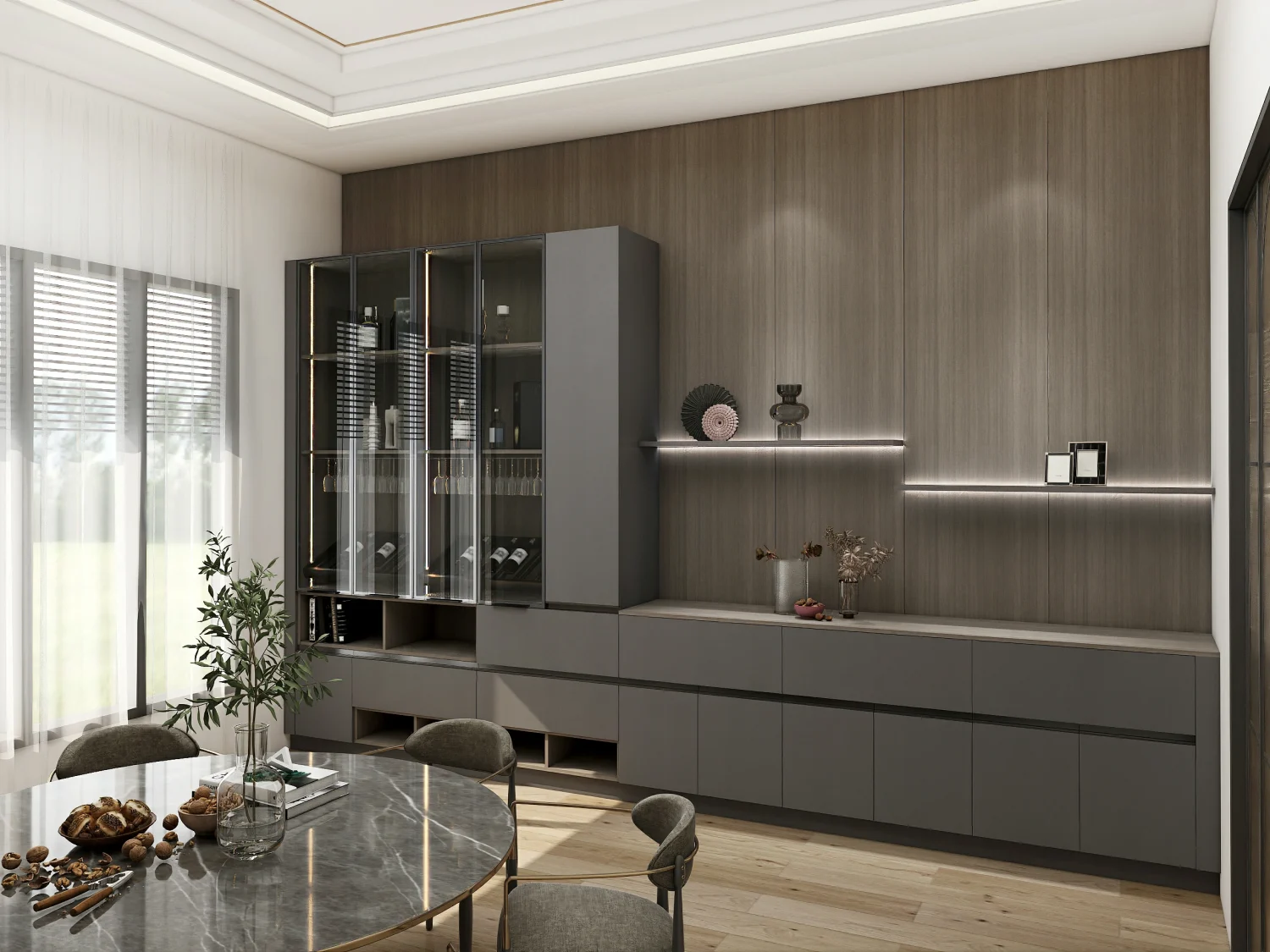What’s the Ideal Dining Room Cabinet for Every Space?
- PA Home
Dining rooms are the heart of shared meals and memories. The right cabinet can transform this space, offering storage, style, and personality. Let’s dive in and answer your biggest questions about dining room cabinets—whether you’re looking for built-ins, corner solutions, budget options, or a supplier you can trust.
What Are the Benefits of Dining Room Storage Cabinets?
Dining room storage cabinets do more than hide clutter. They give you a place to store dishware, linens, and serving pieces neatly out of sight. At the same time, they serve as display areas for your favorite china, glassware, or collectibles .
Built-in shelving and glass-front doors let you showcase what you love. Drawers and adjustable shelves make organization simple. Custom built-in millwork can even bring storage solutions to tight corners, making it ideal for smaller dining rooms .

How Do You Choose Between Built-In Dining Room Cabinets and Freestanding Units?
Built-in dining room cabinets maximize every inch of wall space. They feel seamless with your architecture but can be costly and permanent . Freestanding units, like sideboards or buffets, cost less upfront and can move with you. They’re easier to swap out if your style changes .
Consider your priorities:
- Space efficiency: Built-ins give you custom depths and widths.
- Flexibility: Freestanding lets you reconfigure layouts.
- Installation impact: Built-ins often require professional carpentry.
Which Dining Room Corner Cabinet Layout Maximizes Space?
L-Shaped and Triangular Inset Designs
L-shaped and triangular inset corner cabinets tuck neatly into angles, offering up to 30% more storage than straight-line layouts without blocking traffic flow. These designs create a continuous look when paired with adjacent cabinets .
Pull-Out Solutions and Hidden Compartments
Features like pull-out lazy Susans, sliding trays, and concealed drawers turn dead corners into accessible storage. These mechanisms keep items within reach and let you see everything at a glance, preventing lost or forgotten items .
What’s the Difference Between Budget-Friendly and Luxury Options?
Budget-friendly “cabinet for dining room” picks often include RTA (ready-to-assemble) flat-panel models priced under $500. These use MDF or particleboard and simple hardware. Mid-range units ($500–$2,000) add real-wood veneers and soft-close drawers. Custom solid-wood cabinets start above $2,000, with premium woods and handcrafted details .
| Budget Tier | Materials | Price Range | Lifespan |
|---|---|---|---|
| Entry (< $500) | MDF, melamine | < $500 | 5–10 years |
| Mid ($500–$2,000) | Wood veneer, plywood | $500–$2,000 | 10–15 years |
| High (> $2,000) | Solid hardwood, custom | > $2,000 | 20+ years |
How Can You Customize or DIY Your Dining Room Cabinets?
You don’t need a pro for every upgrade. Simple paint projects can refresh finish and match new décor. Swapping knobs and pulls takes minutes and can redefine style. Adding decorative panels or trim can mimic a built-in look on a budget .
When to call a professional? If you need new framing, plumbing, or electrical work, hire a cabinetmaker or contractor. For light updates, you’ll need:
- Paint supplies (primer, paint, brushes)
- New hardware (knobs, hinges)
- Simple tools (drill, level)
Budget roughly $100–$500 for DIY kits. Higher-level customizations may run $1,000+.
How Do Regional Styles Influence Dining Room Cabinet Design?
Scandinavian Minimalism
Scandinavian cabinets favor light woods, clean lines, and minimal hardware—ideal for bright, airy dining rooms where “dining room cabinets” feel like part of the architecture.
Mediterranean Warmth
Mediterranean designs embrace warm woods, carved detailing, and bold metal accents. A “dining room sideboard cabinet” in this style adds a sun-kissed, rustic charm to coastal or Tuscan-inspired homes.
Neo-Chinese Fusion
Neo-Chinese cabinets blend lacquer finishes, geometric patterns, and subtle traditional motifs. They work beautifully as “dining room china cabinets,” marrying modern lines with cultural flair.
How Do You Find the Best Supplier for Custom Dining Room Cabinets?
A top custom cabinet maker will offer transparent lead times, solid warranties, and Industry 4.0 capabilities like CNC precision cutting . Compare local and overseas options:
- Local: Easier showroom visits, faster service, higher labor costs.
- Overseas (e.g., China, Mexico): Lower unit costs, longer shipping, possible tariffs.
Use this checklist when vetting suppliers:
- Portfolio review: Quality of past projects
- References: Customer testimonials
- Certifications: ISO, ANSI, or other industry standards
- After-sales service: Installation and support
How Do You Maintain and Organize Dining Room Cabinets Long Term?
Keeping your cabinets in top shape is simple. Mix warm water with mild dish soap for routine cleaning. Wipe spills quickly to prevent stains. Test any cleaner in a hidden spot first .
Protect from moisture by avoiding steam and using coasters under vases. Dust cabinet tops weekly to prevent buildup. Inside, use clear bins or labels to categorize items. Declutter seasonally—donate or recycle items you no longer use. A little upkeep keeps your “dining room storage cabinet” looking new for years.
Conclusion
Whether you choose a sleek built-in, a classic sideboard, or a space-saving corner cabinet, smart planning and the right partner make all the difference. Armed with these insights, you can select, customize, and maintain dining room cabinets that boost storage and style while fitting your budget and tastes. Ready to transform your dining space? Contact us for a free quote.
FAQs about dining room cabinet
How much do built-in dining room cabinets cost?
What size should a dining room sideboard cabinet be?
Can a corner dining room cabinet improve storage in small spaces?
How do you maintain a dining room storage cabinet?
Are DIY dining room cabinets as durable as custom cabinets?



